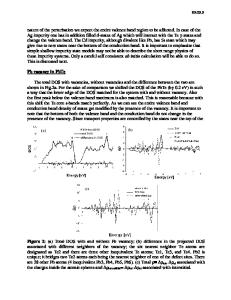Lattice and electronic effects in rutile TiO 2 containing charged oxygen defects from ab initio calculations
- PDF / 1,162,144 Bytes
- 6 Pages / 612 x 792 pts (letter) Page_size
- 46 Downloads / 407 Views
1160-H11-11
Lattice and electronic effects in rutile TiO2 containing charged oxygen defects from ab initio calculations Seong-Geon Park, Blanka Magyari-Köpe and Yoshio Nishi Department of Materials Science and Electrical Engineering, Stanford University, Stanford, CA 94305, U.S.A. ABSTRACT We performed first-principle simulation for the study of oxygen vacancy defect in rutile TiO2 based on density functional theory. The effects of a vacancy on the electronic structure of rutile TiO2 were studied. Here we have employed neutral and charged oxygen vacancy in the supercell to address the resistance switching mechanism. Neutral vacancy induces the band gap states at deep level, ~0.7 eV below the conduction band minimum, which is occupied by highly localized electrons. The calculation results of positively charged oxygen vacancy show that larger atomic relaxation surrounding oxygen vacancy results in the stretching of Ti-O bond around vacancy, thus band gap states are formed near the conduction band minimum.
INTRODUCTION ReRAM is very promising for advanced non-volatile memory technologies in terms of low operating power, high density, better non-volatility, fast switching speed, and compatibility with conventional CMOS process. There exist different switching characteristics that have been established in a variety of materials systems. In fact, it has been known that a few combinations of an oxide with metal electrodes can exhibit resistance switching characteristics. Recently different kind of experimental work has been reported to understand the resistance switching mechanism. Therefore several models have been proposed so far, such as charge trapping [1], the formation of conductive filament [2], the modulation of schottky barrier [3], and electrochemical reduction and oxidation [4]. However, up to date none of these models is completely understood. In order to elucidate the operating principles accurately, in-depth understanding of the resistance switching mechanism at the atomistic level is necessary. In this study, we performed fist-principle simulation for the study of oxygen vacancy defect in rutile TiO2, based on density functional theory (DFT). It is widely believed that defects play an important role in the switching of conducting state in transition metal oxide [5-7]. In fact, it is known that oxygen vacancies in TiO2 generate excess electrons, previously occupying the oxygen 2p orbitals, thus n-type conducting behavior can be shown in oxygen deficient TiO2. Here we calculated the lattice and electronic effects of oxygen vacancy in rutile TiO2 using the local density approximation (LDA) with correction of on-site Coulomb interaction. However, it is found that the electronic structure of TiO2 is not fully described by the on-site Coulomb interaction between 3d electrons, which is critical for the study of defect states within the band gap. In this study, we employ Coulomb interaction of both d and p character for the better description of electronic structure of TiO2.
COMPUTATIONAL DETAILS In this work we
Data Loading...










